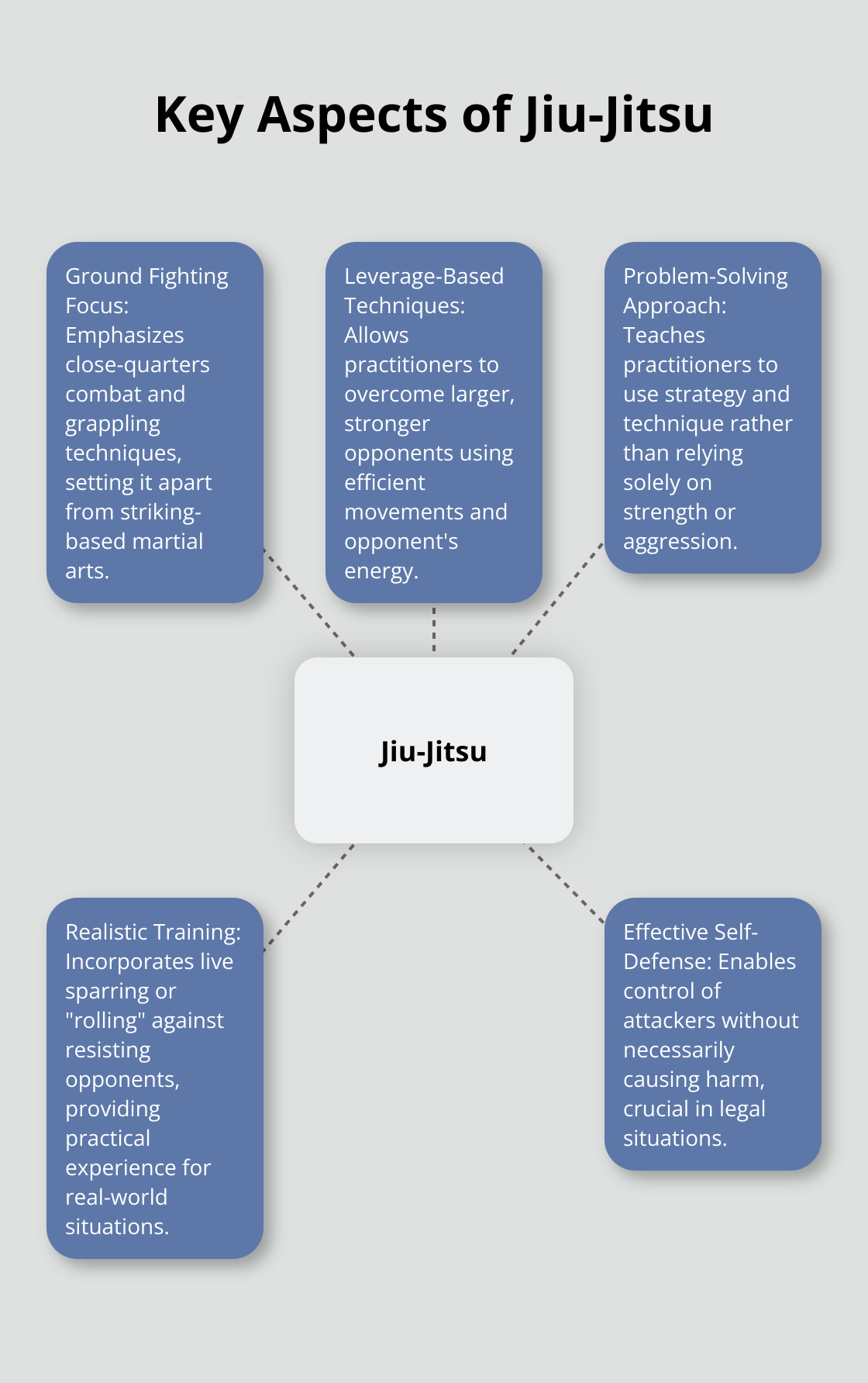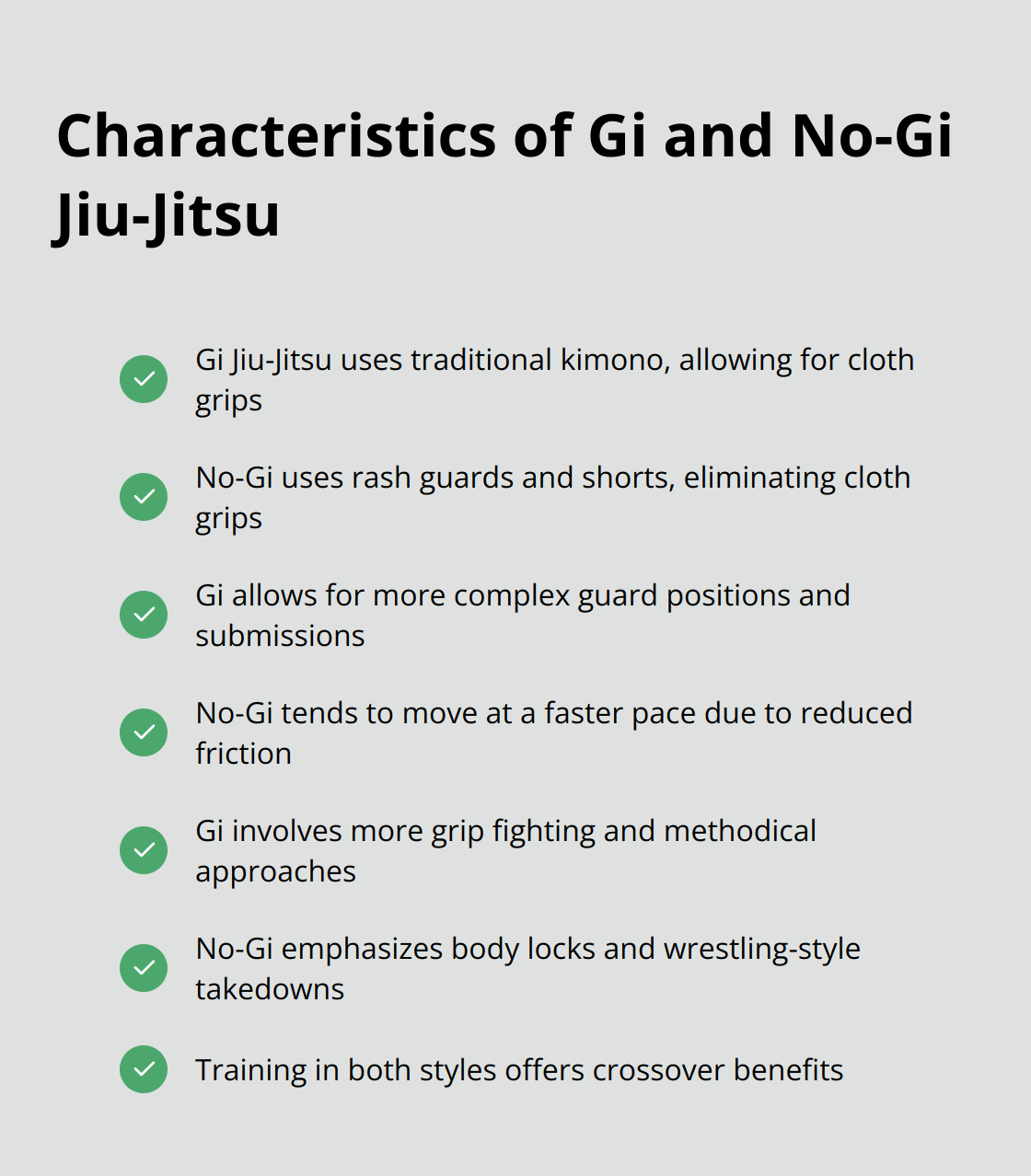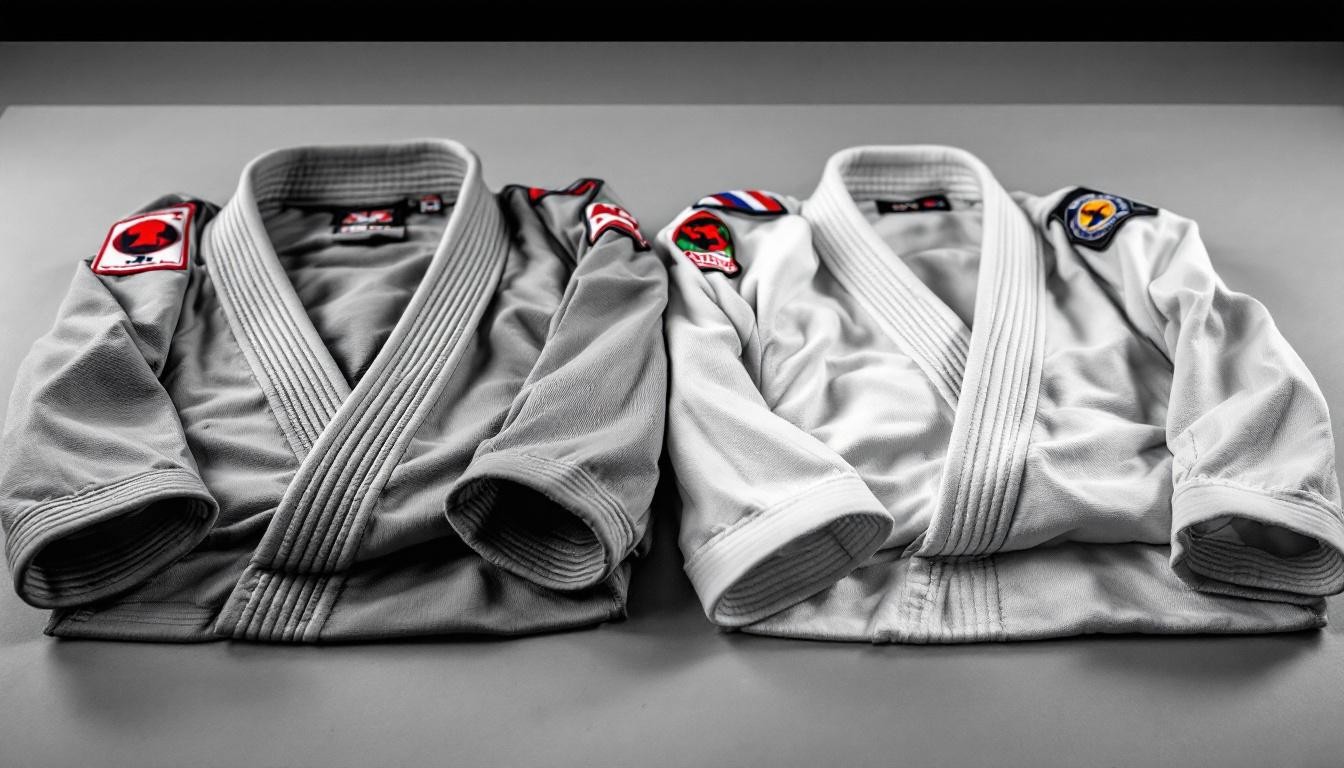At Jiu jitsu, we often encounter questions about the differences between various martial arts and grappling styles. One common query is about Jiu-Jitsu vs. Brazilian Jiu-Jitsu, and how they compare to other combat disciplines.
In this post, we’ll explore the key distinctions between these styles, including their philosophies, techniques, and effectiveness in real-world situations. We’ll also delve into the nuances of Gi and No-Gi training, helping you understand the unique aspects of each approach.
How Does Jiu-Jitsu Compare to Other Martial Arts?
Jiu-Jitsu stands out from other martial arts in several key ways. At its core, Jiu-Jitsu focuses on ground fighting and grappling techniques, setting it apart from striking-based arts like Karate or Taekwondo. This emphasis on close-quarters combat and leverage-based techniques allows practitioners to overcome larger, stronger opponents.
Philosophy and Approach
Jiu-Jitsu’s philosophy centers on efficiency and problem-solving. Unlike some martial arts that rely on strength or aggression, Jiu-Jitsu teaches practitioners to use an opponent’s energy against them. This approach makes it particularly effective for smaller individuals or those with less physical strength.
Techniques and Strategies
The techniques in Jiu-Jitsu primarily involve joint locks, chokes, and positional control. These methods allow practitioners to subdue opponents without causing permanent harm. In contrast, arts like Boxing or Muay Thai focus on striking techniques that can lead to more severe injuries.
Jiu-Jitsu’s strategy often takes the fight to the ground, where its techniques are most effective. This differs from arts like Judo, which emphasizes throws but doesn’t focus as much on ground fighting. A lot of fights end up on the ground, making Jiu-Jitsu’s ground-focused approach highly practical.
Self-Defense Effectiveness
In self-defense situations, Jiu-Jitsu proves highly effective. Its techniques allow practitioners to control an attacker without necessarily causing harm (which can be crucial in legal situations).
Jiu-Jitsu’s effectiveness stems from its realistic training methods. Unlike some traditional martial arts that practice pre-arranged forms or katas, Jiu-Jitsu training involves live sparring against resisting opponents. This approach, known as “rolling,” provides practical experience that translates well to real-world situations.
Training Methods
Jiu-Jitsu’s training methods set it apart from many other martial arts. The focus on live sparring (or “rolling”) allows practitioners to test their techniques against fully resisting opponents. This realistic training approach (often absent in more traditional martial arts) helps develop practical skills that work in real-life scenarios.
Moreover, Jiu-Jitsu’s emphasis on leverage and technique over strength makes it accessible to a wide range of practitioners. Whether you’re a 100-pound woman or a 250-pound man, Jiu-Jitsu provides tools to defend yourself effectively.

As we explore the differences between Jiu-Jitsu and other martial arts, it’s important to understand how these distinctions translate to different styles within Jiu-Jitsu itself. Let’s now examine the key differences between Brazilian Jiu-Jitsu and Traditional Jiu-Jitsu.
Brazilian Jiu-Jitsu vs Traditional Jiu-Jitsu: Unraveling the Distinctions
Brazilian Jiu-Jitsu (BJJ) and Traditional Jiu-Jitsu, while sharing a common ancestry, have evolved into distinct martial arts with unique characteristics. Understanding these differences proves essential for anyone exploring the world of grappling.
Origins and Historical Development
Traditional Jiu-Jitsu, also known as Japanese Jiu-Jitsu, traces its roots back centuries to feudal Japan. Samurai warriors developed it as a comprehensive battlefield martial art, incorporating strikes, throws, and ground techniques. BJJ, in contrast, emerged in the early 20th century when the Gracie family in Brazil adapted and refined techniques from Judo and Traditional Jiu-Jitsu, focusing primarily on ground fighting and submission grappling.
Training Focus and Methodologies
The training methods in these two arts differ significantly. Traditional Jiu-Jitsu often includes a wider range of techniques, including strikes and weapons training, reflecting its origins as a complete combat system. Training sessions may involve more structured, pre-arranged forms or katas.
BJJ places a heavy emphasis on live sparring or “rolling.” This approach allows practitioners to test their techniques against fully resisting opponents, fostering a more dynamic and adaptable skill set. BJJ training sessions typically involve drilling specific techniques followed by extended periods of free sparring.
Competition Styles and Rulesets
Competition styles between these two arts also diverge significantly. Traditional Jiu-Jitsu competitions, when held, often focus on demonstrating pre-arranged techniques or forms. Some styles may include light contact sparring, but full-contact competitions are less common.
BJJ competitions are widespread and highly popular. They typically involve timed matches where competitors aim to score points through positional advantages or win by submission. The International Brazilian Jiu-Jitsu Federation (IBJJF) has established a comprehensive ruleset that governs most major BJJ tournaments worldwide.
Effectiveness in Real-World Scenarios
Both Traditional Jiu-Jitsu and BJJ offer valuable self-defense skills, but their approaches differ. Traditional Jiu-Jitsu often emphasizes quick, efficient techniques for neutralizing attackers in standing situations. BJJ, with its focus on ground fighting, excels in close-quarters combat and situations where the fight goes to the ground (which statistics show happens in a significant number of real-world altercations).
Modern Applications and Popularity
In recent years, BJJ has gained significant popularity, partly due to its effectiveness in mixed martial arts (MMA) competitions. Its practical, pressure-tested techniques have made it a staple in many self-defense and law enforcement training programs. Traditional Jiu-Jitsu, while less widespread, continues to attract practitioners interested in its historical aspects and comprehensive approach to martial arts.

As we explore the nuances between these two grappling arts, it’s important to consider how these differences manifest in training gear and competition settings. Let’s now examine the distinctions between Gi and No-Gi Jiu-Jitsu, two popular training methods within the BJJ community.
Gi or No-Gi: Exploring the Two Faces of Jiu-Jitsu
At Souza Grappling Co., we offer both Gi and No-Gi Jiu-Jitsu classes to cater to different preferences and goals. These two styles, while rooted in the same martial art, present distinct experiences and challenges.
Dress Code Distinctions
The most apparent difference between Gi and No-Gi Jiu-Jitsu lies in the attire. Gi Jiu-Jitsu requires practitioners to wear a traditional kimono (often called a Gi) along with a belt indicating their rank. This heavy cotton uniform provides numerous gripping opportunities. No-Gi, in contrast, involves wearing form-fitting rash guards and shorts or spats, which eliminate most cloth grips.
Technique Variations
The clothing difference significantly impacts the techniques used in each style. Gi Jiu-Jitsu allows for a wider range of grips on the uniform, which leads to more complex guard positions and submissions that rely on manipulating the Gi. Collar chokes, for instance, are a staple in Gi Jiu-Jitsu but absent in No-Gi.
No-Gi Jiu-Jitsu tends to move at a faster pace due to reduced friction and fewer gripping options. Practitioners often focus more on body locks, underhooks, and overhooks. The lack of Gi grips also means that maintaining control positions can prove more challenging, requiring excellent pressure and body positioning.
Strategic Approaches
The strategic approach in Gi and No-Gi Jiu-Jitsu can differ significantly. Gi Jiu-Jitsu often involves a more methodical, slower-paced game where grip fighting plays a crucial role. Practitioners might spend considerable time battling for advantageous grips before executing techniques.
No-Gi Jiu-Jitsu typically features quicker transitions and a higher emphasis on wrestling-style takedowns. The reduced friction allows for faster movements, making it easier to slip out of bad positions but also more challenging to maintain dominant ones.
Crossover Benefits
While some practitioners prefer one style over the other, training in both Gi and No-Gi can offer significant benefits. Gi training can improve grip strength and patience (skills that translate well to No-Gi). Conversely, No-Gi training can enhance speed and reaction time (benefiting Gi performance).
Many top-level competitors excel in both styles. For instance, Marcus Almeida (known as “Buchecha”) has won multiple world championships in both Gi and No-Gi divisions, demonstrating the value of versatility in training.

Final Thoughts
Jiu-Jitsu and Brazilian Jiu-Jitsu offer unique benefits for martial arts enthusiasts. The distinctions between these styles highlight the evolution of grappling techniques and training methodologies. Understanding these differences helps practitioners choose the path that aligns with their goals and preferences.
Exploring various martial arts styles enhances overall skills and understanding. Jiu-Jitsu’s focus on ground fighting and leverage-based techniques makes it highly effective for self-defense. Brazilian Jiu-Jitsu’s emphasis on live sparring and practical application has contributed to its popularity in recent years.
We invite you to experience these different styles firsthand at Souza Grappling Co.. Our facility offers a range of classes (including Jiu-Jitsu, Muay Thai, and self-defense) for all skill levels. With expert instructors and a supportive community, you can discover which style resonates with you and start your martial arts journey today.




